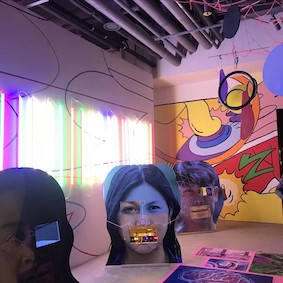In the basement of the K Museum of Contemporary Art (KMCA) lies its latest exhibition stylishly titled “Museum Therapy: Dear Brain”. Relaxing your brain through audiovisual stimuli is the purported intent, advertized with colorful photo spots and meditative background music. Unfortunately, my brain did not enjoy the experience. Bright neon signs on top of patterned primary colors were far from soothing, and the meditative sounds were muffled by constant camera shutter noises and a high-pitched screech from an unknown source. But at least I got some decent pictures for my feed, right? Wrong. The dark lighting used to accentuate the neon signs made it pretty much impossible to photograph individuals; at the same time, the exhibits themselves were too bland to capture on their own. I left the building regretting my wasted time and money while pondering about the source of demand for such a superficial attraction — and at its core, I found online self-advertisement.

The rise of social media has fundamentally changed the way individuals communicate, and indirectly, it has also transformed the way sellers communicate with their customers. Before social media, advertising was already one of the greatest beneficiaries of the World Wide Web; then, synergy with platforms such as Facebook enabled specific demographics to be targeted. Thus far, whether offline or online, advertising was unidirectional — from seller to consumer. This is when online advertising was transformed by a simple idea: let them do it for you. And was no platform more fit than the photo- and video-sharing service, Instagram. But first, you had to make them want to, and in order to do so, the product had to be worthy of sharing, or “Instagrammable”. The first step is to redecorate the place: soft colors, a minimalistic design, and a neon sign for people to take pictures. Then, make every item on the menu as pretty as possible: symmetric plating and neat silverware are a bonus. Those who adopted these techniques reaped their benefits; soon enough, people were lining up to visit the prettiest café. Even otherwise, unextraordinary spots can participate in the trend by offering a free drink in exchange for an upload with the right hashtags.
Making one consumer attract another is by no means a new concept. Word of mouth promotion has existed since the beginning of consumer society and is often times our most trusted source of opinion. A friend telling us about a fancy meal they enjoyed the night before makes us want to partake in that experience. The same psychology is in effect when scrolling through pictures on Instagram: a slice of that soufflé pancake along with that pink lime mojito looks like the perfect Saturday brunch. However, while the contents of the picture may look pretty and delicious, it says very little about the actual experience. Nonetheless, a single share is capable of reaching much farther than a positive word, and sellers can abuse this extensive drip-feed into people’s lives.
On my way to the exhibition, I noticed an unusually long line outside a restaurant that sells bunshik, or Korean street food. Curious, I googled the place to find out what is so special about this particular place. Listed on the menu was the usual — spicy rice cake, stir-fried rice, and pork cutlet sandwiches. The reviews were not too positive either — too pricey, crowded and noisy, and not even particularly tasty — but all of them unanimously confirmed that the food is “Instagrammable”. I highly doubt that the people standing in line were unaware of these reviews.
The exhibition at the KMCA is a prime example of the issue at hand. It is an art gallery that features no particular artist or art movement; it exists solely for people to take pictures, but fails to even provide decent photo spots; it is an empty product misguided by a popular movement. Still, there was a continuous flow of people coming to experience their share of “museum therapy”. What does any of this matter if people are enjoying themselves? The primary goal of restaurants should be to serve delicious cuisine to their customers; photogenic plating should not become a priority. An art gallery should feature meaningful content before turning every corner into a photo zone. Visiting these places means we are endorsing tasteless, expensive food and vacuous art. I do not want to sacrifice quality for the façade of satisfaction.

